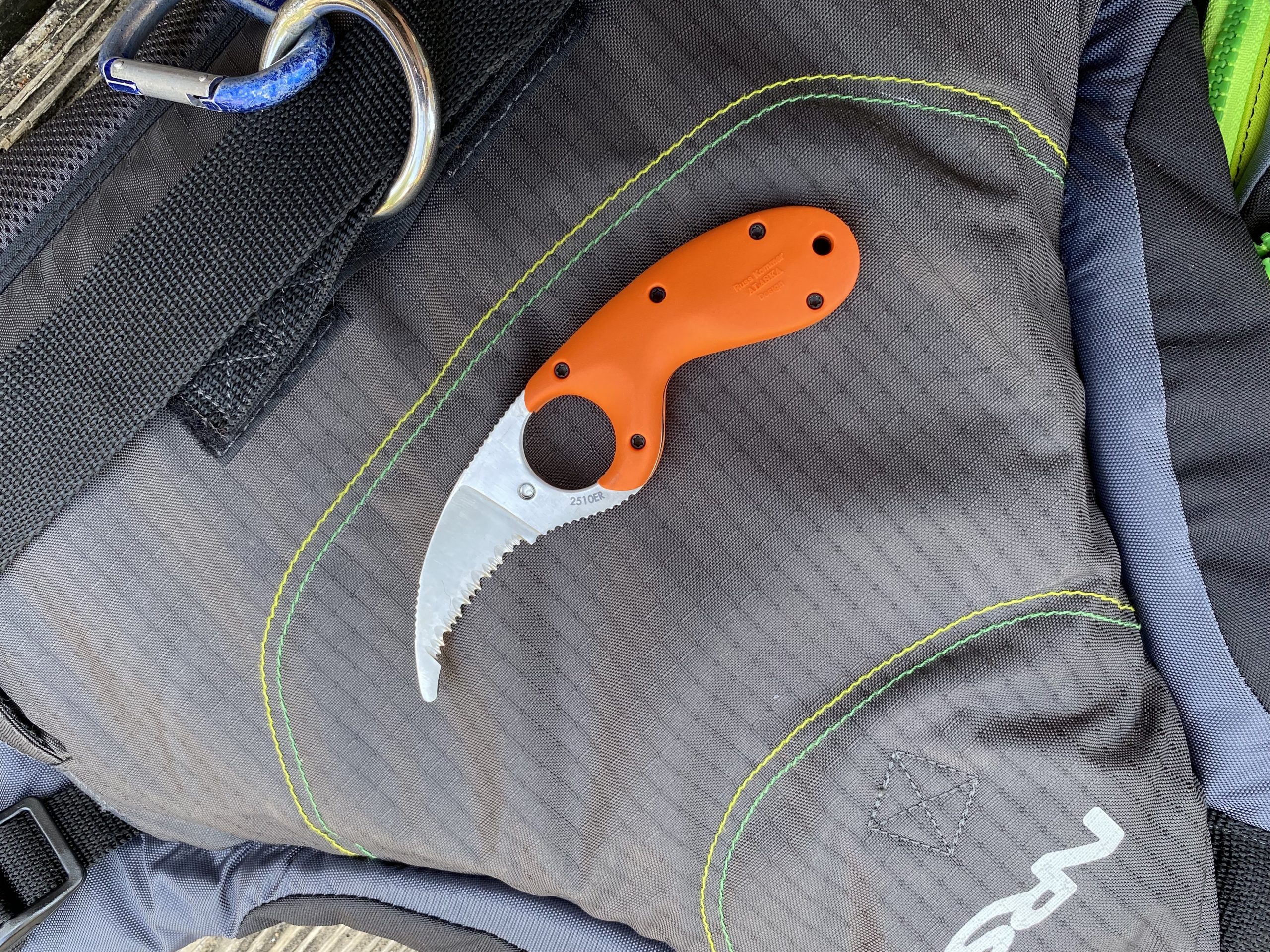It is time again for a healthy dose of purpose-driven design, and the CRKT Bear Claw provides just that. This oddball fixed-blade has a couple of key design elements that the folks at Columbia River Knife and Tool have baked into a knife built to get you out of a serious jam. If you are looking for a solid emergency fixed blade for ripping through ropes, webbing, or even plastics—the Bear Claw E.R. should be at the top of your list.

What is the Bear Claw E.R.?
The Bear Claw concept originated with Russ Kommer, an Alaskan who built the knife as a self-defense tool for women. Should you, for purposes of self-defense, need a good compact claw, this would be an ideal choice. It would function in much the same way as a karambit might, only with the blade kicking out of the top of your fist rather than the bottom.

That original design had a sharp point. This version is less about defense and more about rapid response.
Bear Claw E.R. Specifications
- Blade Length: 2.38″ (60.33 mm)
- Blade Edge: Triple Point Serrations™
- Blade Steel: AUS 4
- Blade Finish: Mirror
- Blade Thickness: 0.13″ (3.30 mm)
- Overall Length: 5.75″ (146.05 mm)
- Weight: 3.40 oz. (96.39 g)
- Handle: Glass-Reinforced Nylon
- Style: Fixed Blade Knife w/Sheath
- Sheath Material: Thermoplastic
- Sheath Weight: 1.10 oz. (31.18g)
The E.R. part should be easy enough to see. As an Emergency Rescue knife, this design excels. It has a short, curved cutting edge full of deeply serrated teeth. As I’ve noted before, this provides a longer cutting edge and can generate force like saw teeth.

The top of the blade is rounded over and dulled. This allows the edge to be slipped under clothing, or a seatbelt, or even wedged deeply between skin and tight rope. It would hurt, as the backside of the blade has a crisp edge grind, but it would be better than trying to get a traditional pocketknife or fixed blade under between rope and skin.
The Handle
The grip isn’t long. This provides one clear advantage, though, which is that the grip isn’t long. The compact knife is easy to mount on a life jacket or a vest or a bag—and it isn’t large enough to be a hindrance to range of motion. I’ve worn this one knife on my chest both vertically and horizontally and it hasn’t ever gotten in my way.

While there’s no real grip texture to the orange G10, the bulbous design fits neatly in your hand, with the blade up or down. That hole in the blade is the ideal spot to anchor a finger. For some tasks, it is enough to just place the finger there as a point of reference. If you really need to apply a ton of cutting power, the knife becomes part of your closed fist and won’t slip.

I’m 6’4”. My hands aren’t huge, but they’re not small. I’ve yet to find a position with the Bear Claw that doesn’t feel perfectly natural, even though I can’t get it over my second knuckle. MY ring gauge tells me it is a size 12.
Back to the purpose part
I don’t jump out of planes. Never have. And I’m not riding with an EMS crew. Both occupations, as I see them, might make excellent use of a knife like this.

When I bought this knife a few years back, I was looking for a whitewater knife. I live in Arkansas, where there are some epic wild rivers. While the whitewater rarely gets above the class III rating, the undammed rivers are prone to flooding that shifts trees and obstacles into the channels. These strainers are sometimes problematic for boaters.

I do most of my floating with Scouts, who tend to end up involuntarily swimming through rapids. As anyone with any swift water rescue training knows, ropes are as problematic as they are useful. What can be a true lifeline can literally drag a person under just as fast.
Be Prepared
I advise everyone I meet to carry a knife. Why wouldn’t you? But if you work with ropes and water, it is a must.



After I picked up the Bear Claw, I ran some tests on some scrap. I put old sections of rope under tension and hit them with the knife. There was no practical rope 1” thick or less that I couldn’t muscle through with one stroke.
Webbing and seatbelts provided the same basic level of resistance. The wide-flat seatbelt webbing wasn’t as easy, but that had more to do with the width of the belt and the curve of the short blade. Once you find the angle—moving the belt back on your hand instead of starting with it resting on the blade—the same one-stroke motion is enough to run it through.


The Bear Claw comes with orange or black glass-filled nylon scales. The black is obviously better for those who don’t want the orange handle shining like a beacon. I do. If I ever drop this in water, I’d like to have every advantage available to help me retrieve it—even if that means diving and looking for it underwater.
Practical Use of the Bear Claw
I’ve used this in saltwater and in freshwater. After each session, I rinse it in clean water and put it up. The sheath lives on my PFD, but I keep the knife high and dry when I’m not on the water, which is all of the maintenance the stainless blade will ever need. AUS4 was, not that long ago, a wiz-bang stainless that promised excellent edge retention and corrosion resistance.


The grip, though, may need more love. I’ve never stripped off these scales, but I’m beginning to see the signs here that I might need to. A bit of corrosion is showing on the edge of the tang. Nothing a decent cleaning wouldn’t have prevented.
Final thoughts
Price? MSRP $48. It seems like retail is hovering below $40, but everyone is out of stock. Most sites are listing the sale options as “pre-order” and noting that restock shipments have been delayed. Hopefully, they’ll get that sorted.


The knives should be available with a sharp tip and a clean cutting edge, or in this rescue set up. Either way, it is a formidable tool.


